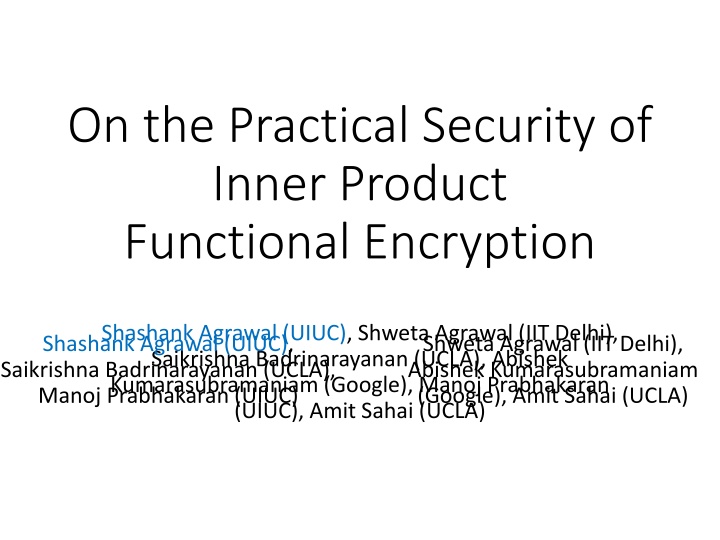
Practical Security of Inner Product Functional Encryption Study
Delve into the realm of practical security in inner product functional encryption with a focus on fine-grained access control, security definitions, standard model challenges, and different approaches to achieving security goals.
Download Presentation

Please find below an Image/Link to download the presentation.
The content on the website is provided AS IS for your information and personal use only. It may not be sold, licensed, or shared on other websites without obtaining consent from the author. If you encounter any issues during the download, it is possible that the publisher has removed the file from their server.
You are allowed to download the files provided on this website for personal or commercial use, subject to the condition that they are used lawfully. All files are the property of their respective owners.
The content on the website is provided AS IS for your information and personal use only. It may not be sold, licensed, or shared on other websites without obtaining consent from the author.
E N D
Presentation Transcript
On the Practical Security of Inner Product Functional Encryption Shashank Agrawal (UIUC), Shweta Agrawal (IIT Delhi), Saikrishna Badrinarayanan (UCLA), Abishek Kumarasubramaniam (Google), Manoj Prabhakaran (UIUC), Amit Sahai (UCLA) Shashank Agrawal (UIUC), Saikrishna Badrinarayanan (UCLA), Manoj Prabhakaran (UIUC) Shweta Agrawal (IIT Delhi), Abishek Kumarasubramaniam (Google), Amit Sahai (UCLA)
Functional Encryption Fine-grained access: ciphertext for ?, key for ? ?(?). Boneh, Sahai and Waters [TCC 2011] and O Neill [Eprint 2010]. Bellare and O Neill [CANS 2013], Barbosa and Farshim [PKC 2013], Agrawal et al. [CRYPTO 2013], Caro et al. [CRYPTO 2013]
Important questions Can we hide the function? Learn only function s output? Keys after ciphertexts?
Security definitions Indistinguishability Simulation simulate view using function values distinguish encryptions Adaptive vs non-adaptive One vs many {1, many} {NA, AD} {IND, SIM}
Standard model woes Can we hide the function? [BRS13a, BRS13b] Indistinguishability Learn only function s output? [BSW11]
Standard model woes Simulation Many-AD-SIM 1-NA-SIM Impossible for IBE [BSW11] Not possible for PRFs [AGVW13]
Tricky situation Indistinguishability Simulation Not good enough Too strong Should we be content with achieving a weaker notion of security?
Two approaches In-between IND and SIM [AGVW13, BF13, AAP15] address as many usage scenarios as we can but consider attacks that are practically feasible
This work Strong UC-style definition of security. Secure scheme for inner-product predicates. Concrete security analysis. Obfuscation for hyper-plane membership. Generic group model (GGM).
Functional Encryption Name Input Output ? Setup mpk, msk mpk, ? ??? Encryption msk, ? ??? Key Generation ?(?) ???,??? Decryption
Real World ????????(1?) Ideal World ?????????(1?) ?1,?2, ,?? 1 ?1,?2, ,?? 1 ,?? MSK, MPK MPK ,?? ??? (?1) ,???(??) ?1??,?2??, ,?? 1(??) ???1,???2, ,??(??) ???1 ,???? Adversary Simulator System Admin Oracle ?1 ?? ,?? ?1 ?? ,?? Switch to PK mode Switch to PK mode Environment Environment ??? ??? ???,????????1? ?????????(1?)
Highlights Clean and intuitive definition. Both public and private key settings. All the desirable features: Can we hide the function? Learn only function s output? Keys after ciphertexts?
But, wait! Simulation based security impossible to achieve. Yes, but in standard model. Generic group model, captures a large class of real- world attacks.
Generic group model Abstraction that hides structure of groups. Algorithms access elements via handles. Two groups: ? and ??, bilinear map ?:? ? ??. Using handles, multiply, invert, pair, check for equality. Admissible relations: ?1, ,? and ?1, ,?? represent elements in ? & ??. ????= 0, ????+ ??,?????= 0.
Bypassing impossibility Adversary performs group operations via generic group oracle which simulator can control. Simulator keeps track of queries. Learn what adversary is doing. Carefully program the oracle to behave like the real world.
On the assumption Pairing friendly elliptic curves subject to extensive research. Two types of attacks: Generic & non-generic. Long line of work on curves where complexity of all-known non-generic attacks very high [F06, FST10, AFKMR12, C12]. Heuristic evidence that practical attacks will be generic in nature. Concrete analysis: 222-bit prime group order, 280 generic operations, 2 60 success probability.
Inner-product Predicate [KSW08] Powerful functionality: Identity-based encryption (IBE). Polynomials, CNF, DNF formulas. ? = ?? ? = (?1, ,??)}. ? = ?, ? ? = (?1, ,??)}. ??(?, ?) = ? iff ?. ? = 0.
Dual Pairing Vector Spaces Randomly choose , ,?? ) s.t. ? = (?1, ,??) & ? = (?1 ??? = ? ?, , ? is the identity matrix [OT08]. where ? ??
Construction Public parameters: ?,?,??,? Master public key: certain linear combinations of vectors in ? and ? . Master private key: ?,? , Starts with KSW08, apply transformations developed by Fre10, OT08, OT09, Lew12.
Conclusion An FE scheme for inner-product predicates strongly secure under the generic group model. Use other meaningful abstractions like ROM. Design schemes for other functionalities like IBE, ABE, etc.
